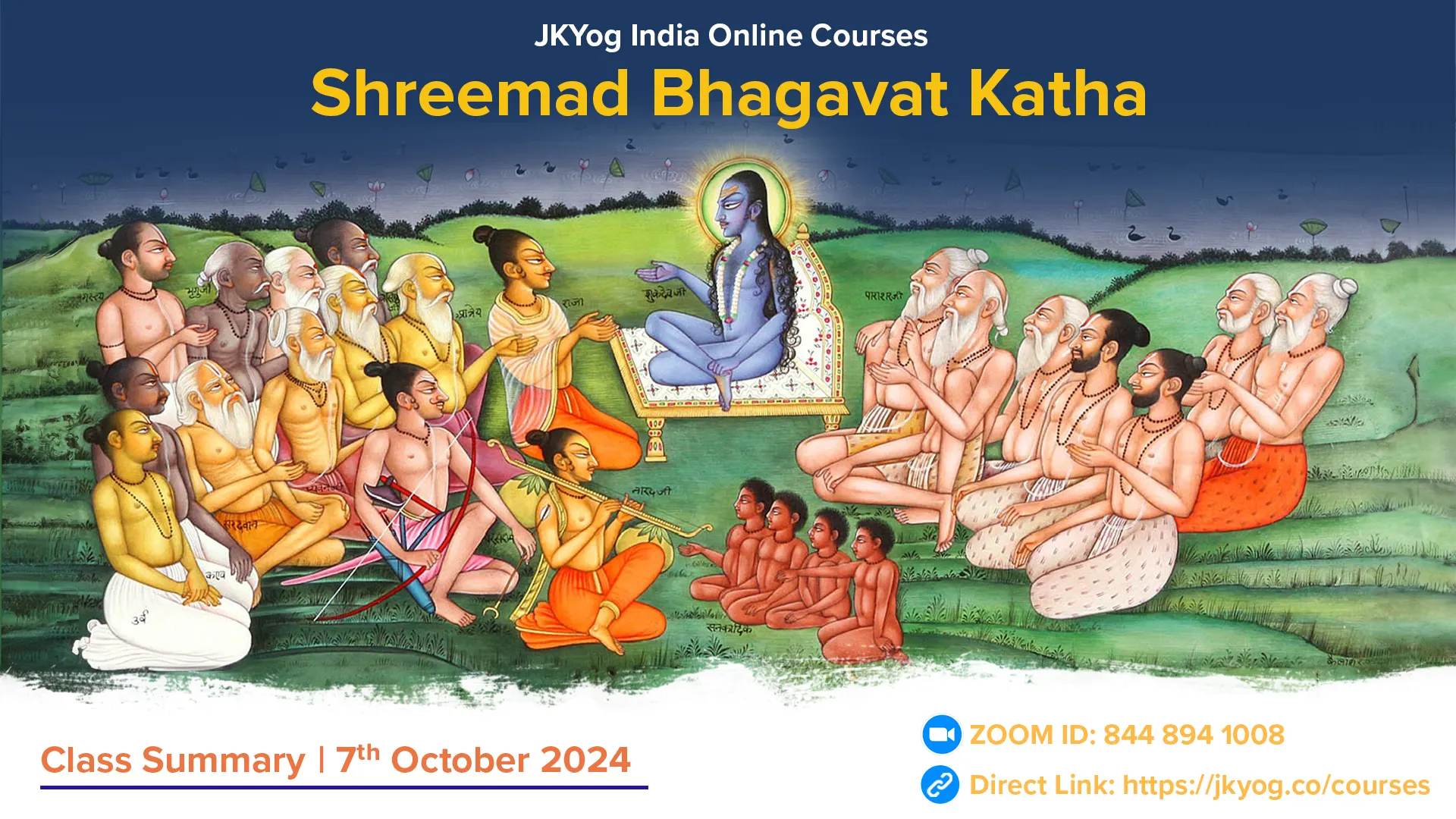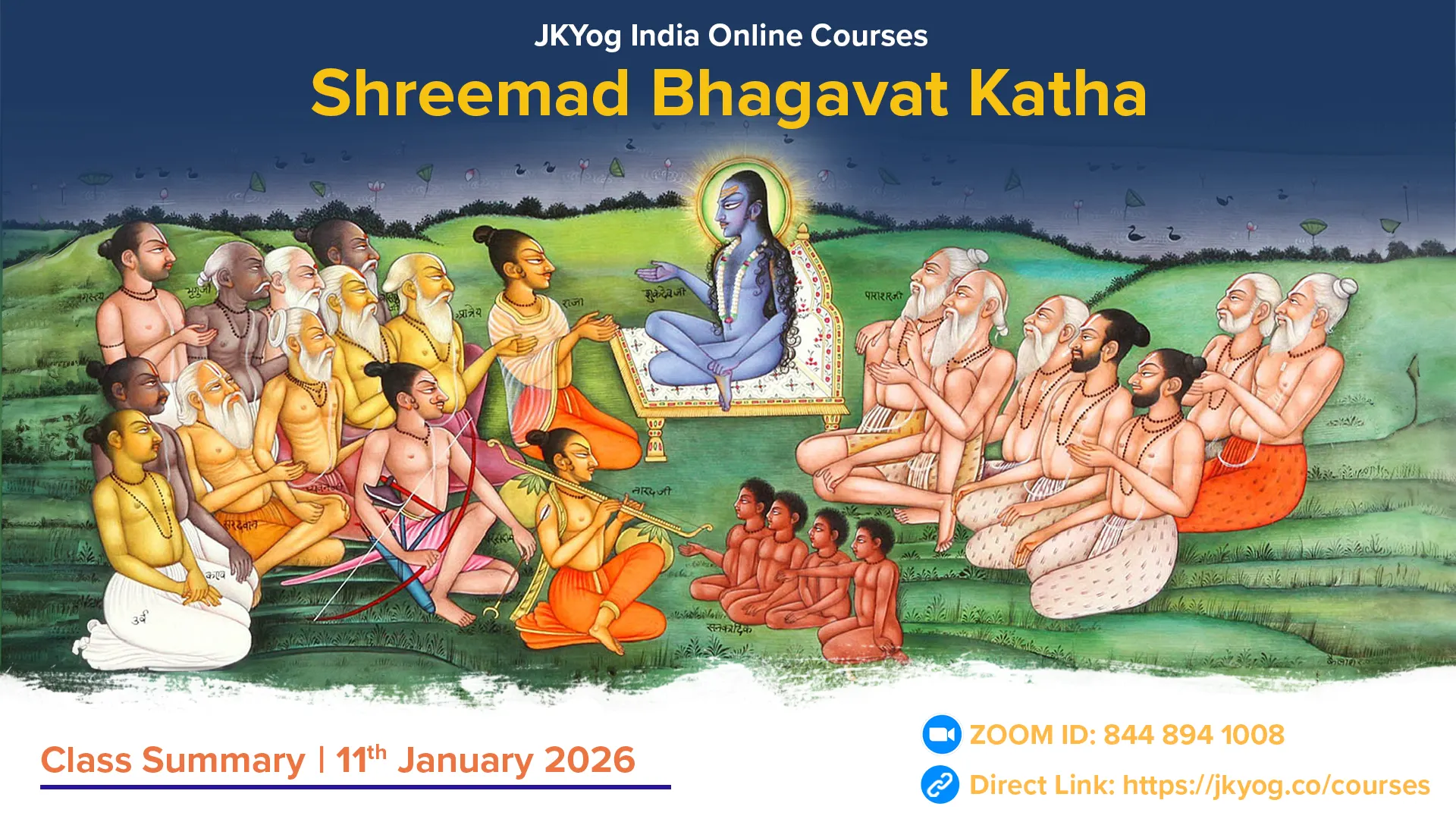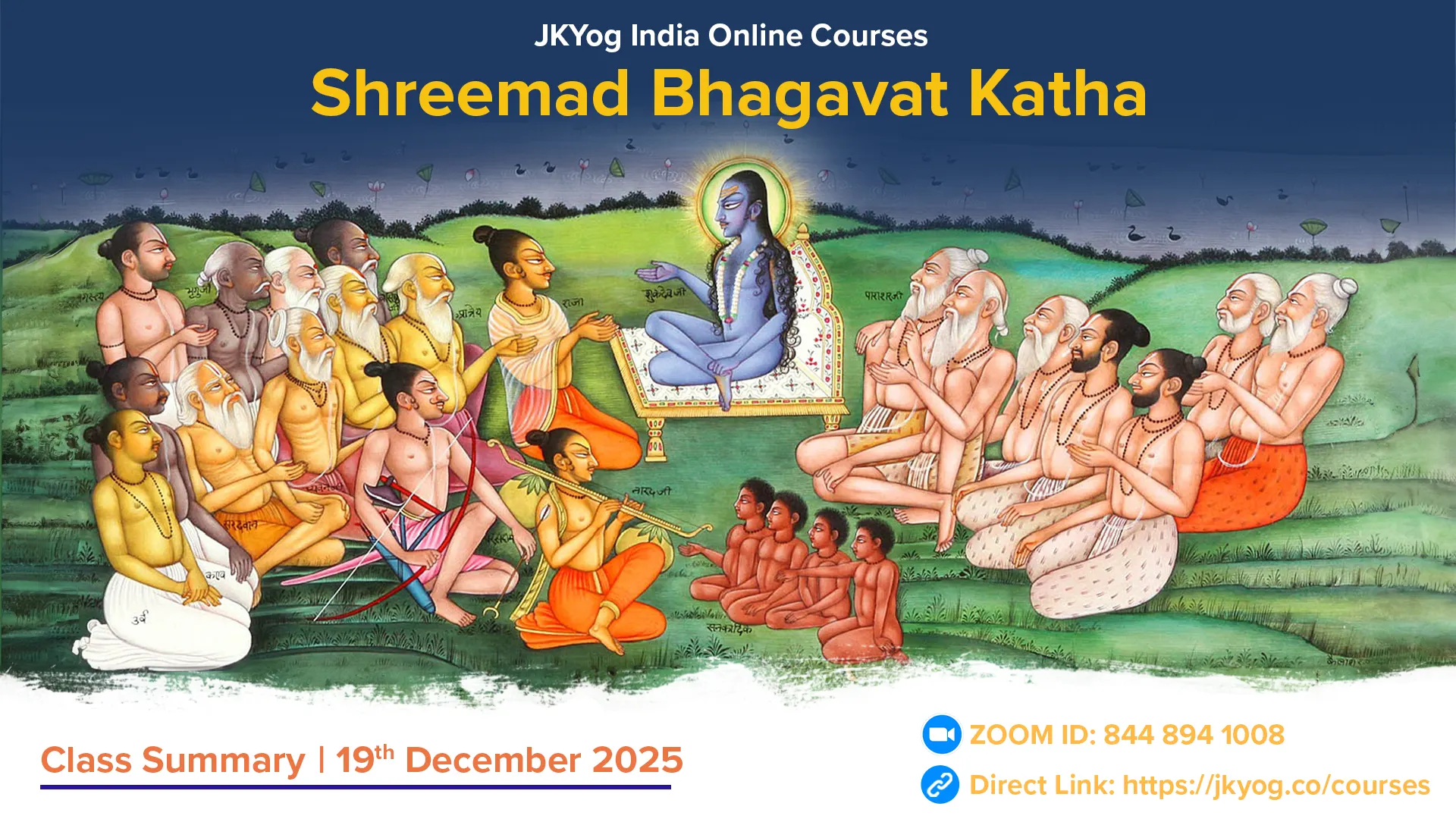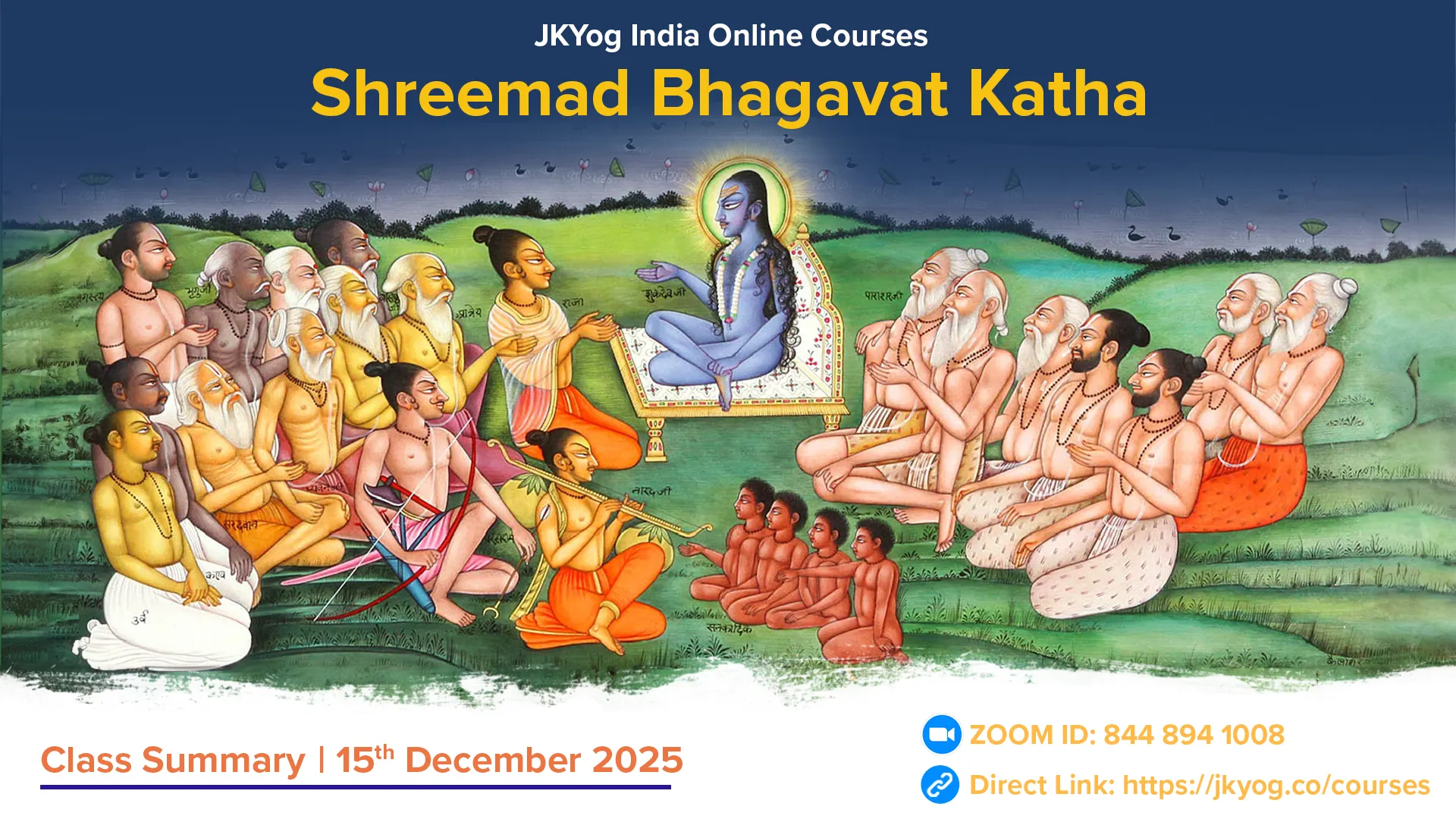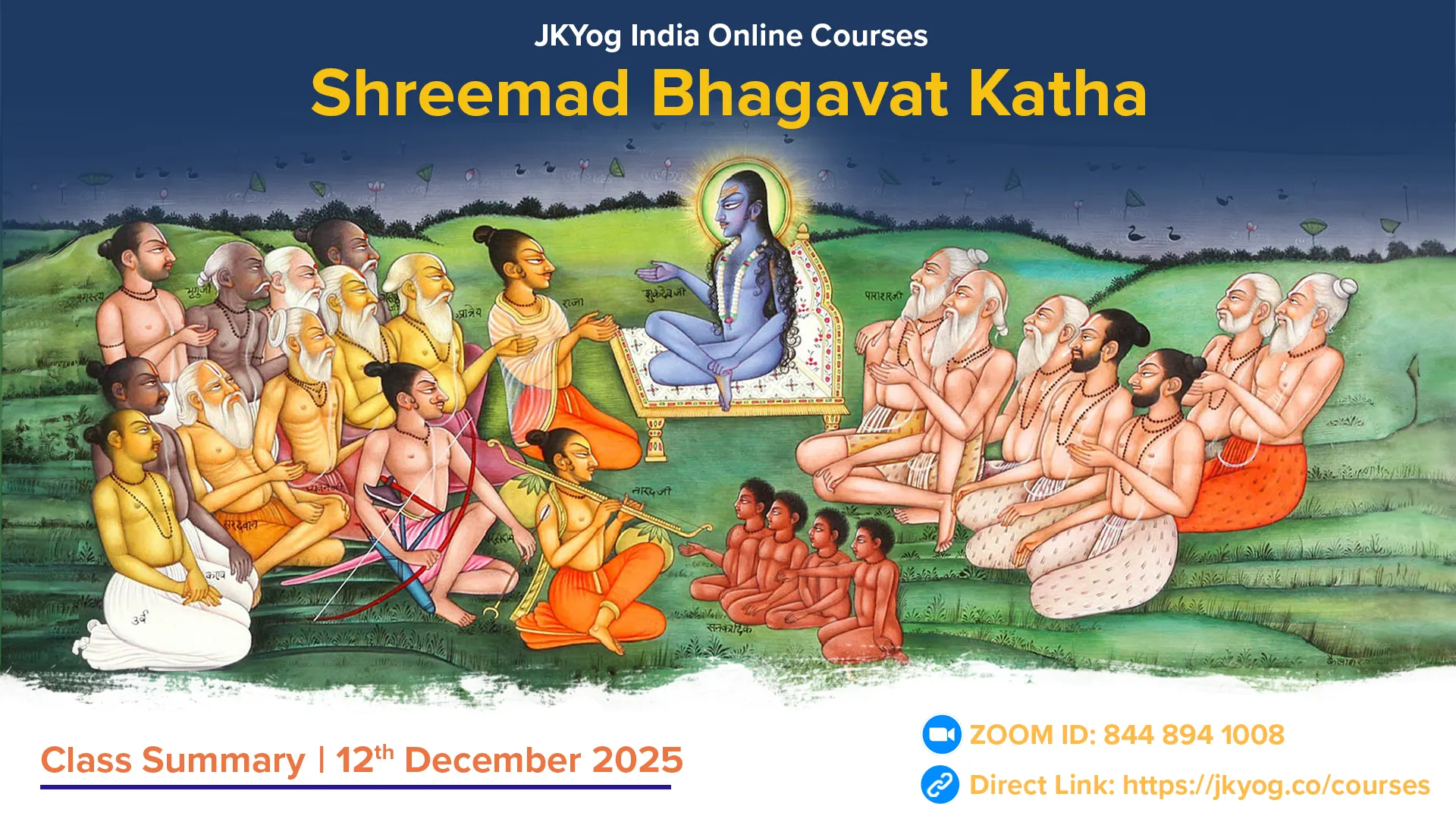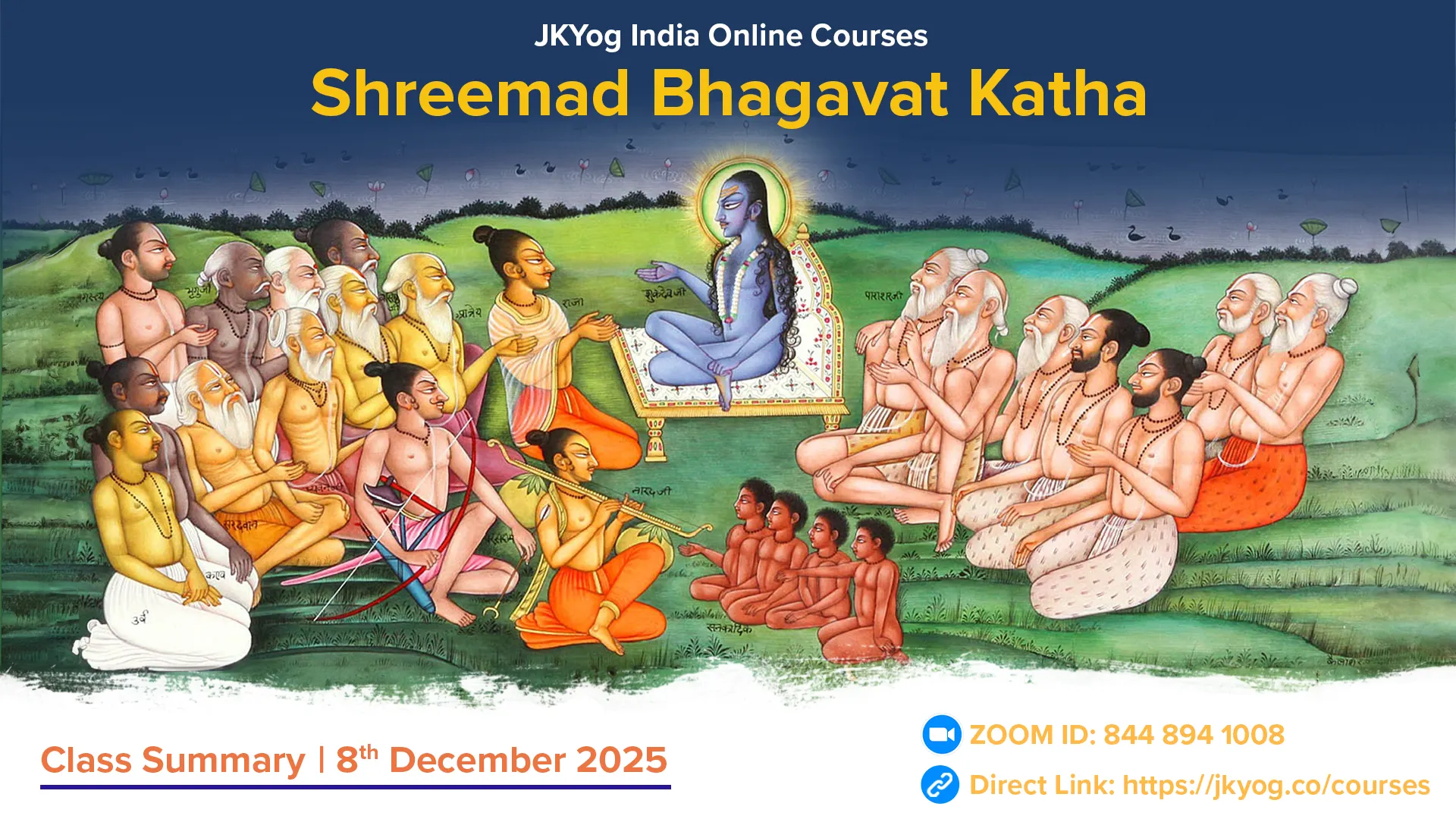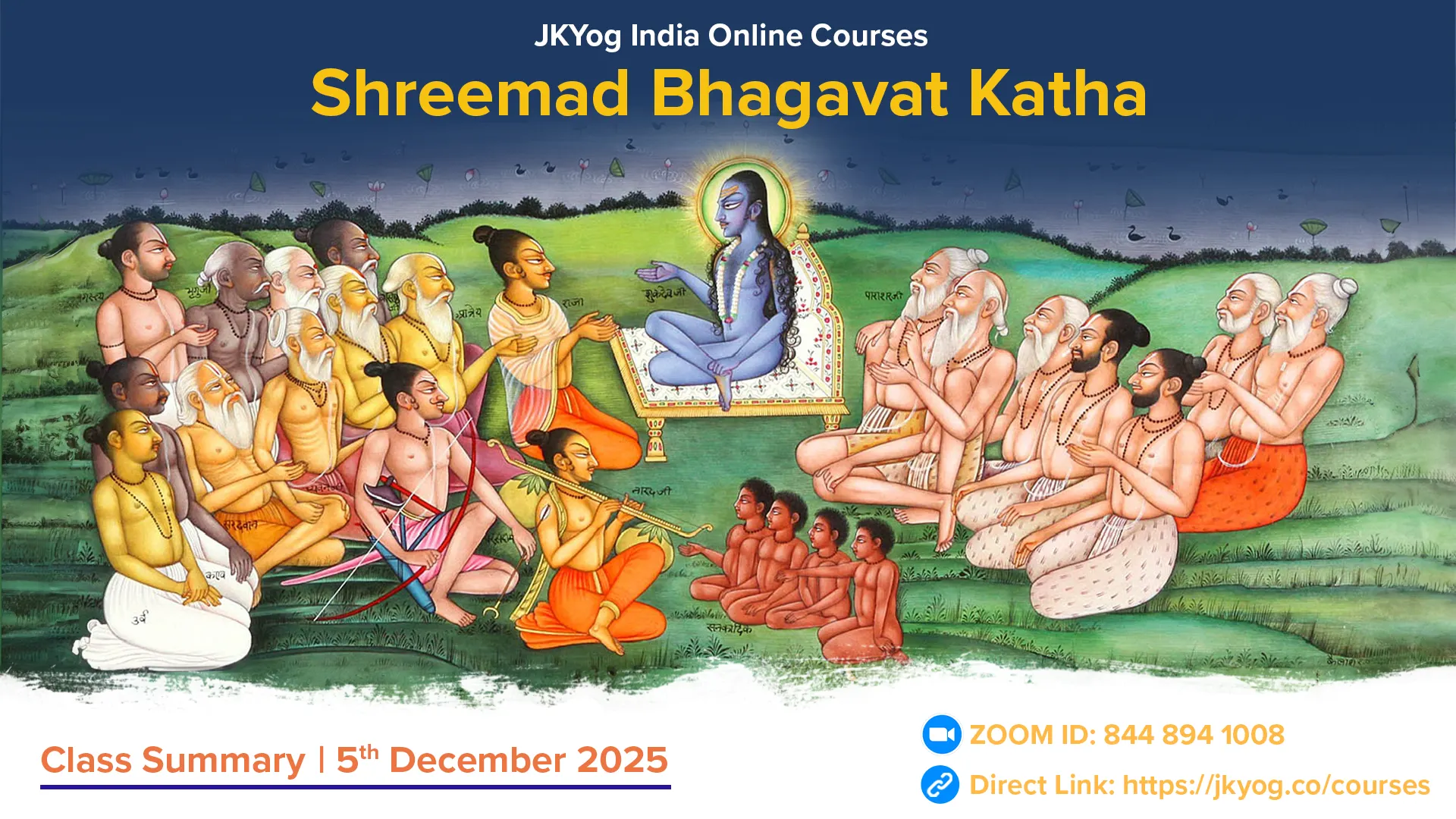Shreemad Bhagavat Mahapuran- Canto: 3, Chapters: 28 & 29
Sankhya Philosophy -The Practice of Ashtanga Yog, Essence of Devotion, and the Glory of Kaal
Bhagwan Kapil tells Mata Devahuti: "Now I will explain to you the characteristics of sabeej (meditation supported by an object of focus) Yog, by which the mind becomes purified and blissful, enabling it to proceed on the path toward the Supreme Soul."
Swadharma-acharanam shaktyaa vidharmaachcha nivartanam
Daivaal-labdhena santosh aatmvita charana-archanam
Graammy-dharma-nivrittisch moksha-dharma-ratistathaa
Mitame-dhyaa-danam shashvad vivikta-kshema-sevanam
Ahimsa satya-masteyam yaavadartha-parigrahaha
Brahmacharyam tapaha shaucham swaadhyaayaha purusha-archanam
Maunam sadaa'sanajayaha sthairyam praana-jayaha shanaiha
Pratyahaara-shchendriyaa-naam vishayaan manasaa hridi
Following one's swadharma (self-duty) as prescribed by the scriptures to the best of one's ability, and avoiding actions contrary to the scriptures; remaining content with whatever comes according to prarabdha (destiny); worshipping the feet of self-realised souls; staying away from actions that increase sensual desires; cultivating love for Dharma that liberates one from the bondage of the world; eating pure and limited food; continuously residing in solitude and a fearless place; not hurting any being through mind, speech, or body; speaking the truth, not stealing, not hoarding more than what is necessary; practicing celibacy; performing penance (enduring hardships for the sake of righteousness); staying pure internally and externally; studying the scriptures; worshipping Bhagwan; controlling speech; practicing good postures and sitting steadily; gradually mastering the breath through pranayama (breath control); withdrawing the senses from their objects through the mind and directing them into the heart. (Bhagavat 3.28.2-3-4-5)
Concentrating the prana (life force) along with the mind at one of the centres, such as the mooladhara chakra, and continuously contemplating the divine pastimes of Bhagwan while immersing the mind in this meditation is the path. Through these practices, along with other methods like vows, charity, and so on, one should carefully control the prana and gradually concentrate the unrighteous, distracted mind with the intellect, directing it towards the meditation of the Supreme Soul.
The first step is to practice asana (posture). Prepare a seat by spreading kusha grass, deerskin, or similar material in a clean place, and sit comfortably, keeping the body straight and steady. To purify the path of the life force (prana vayu), practice the three processes of pranayama: inhaling (puraka), holding the breath (kumbhaka), and exhaling (rechaka). Initially, perform pranayama by inhaling through the left nostril and then exhaling through the right. This practice stabilises the mind.
Just as gold is purified by fire and air, the mind of the yogi is swiftly purified through the practice of pranayama. It removes imbalances caused by vata, pitta, and other doshas (bodily humors). With dharana (concentration), one eliminates sins; with pratyahara (withdrawal of the senses), one detaches from sense objects; and with dhyana (meditation), one removes the negative traits like attachment and aversion that turn the mind away from Bhagwan.
When, through the practice of Yog, the mind becomes pure and concentrated, one should fix the gaze at the tip of the nose and meditate on the entire form of Bhagwan. Bhagwan’s pastimes are incredibly captivating; therefore, depending on one’s preference, one should meditate on His form—whether standing, walking, sitting, lying down, or as the inner witness—while cultivating pure, heartfelt devotion.
Once the yogi realises that the mind is fully absorbed in Bhagwan’s divine form, he should concentrate the mind on each part of His form. Through this practice of roopdhyan (form meditation), the seeker develops a deep love for Shree Hari. His heart melts with devotion, his body experiences the thrill of joy, and out of the intense love and longing, tears stream down his face, bathing his body again and again. Like a fisherman reeling in a fish with his line, the yogi slowly withdraws his mind, which had been fixed on Bhagwan, and directs it away from the object of meditation.
Just as a lamp's flame extinguishes when the oil runs out and merges back into its source, the element of light (tejas tattva), similarly, when the mind becomes free from ashraya (refuge), objects of desire and attachment, it attains peace and merges with Brahman (the Supreme Reality). In this state, the individual soul (jeev), freed from the bondage of the body and its attributes, no longer perceives any distinction between the meditator and the object of meditation. Everywhere, the yogi sees only the indivisible, omnipresent Supreme Soul.
Through the practice of Yog, when the mind is freed from ignorance (avidya) and attains complete peace, the yogi begins to experience his true essence as Brahman (the Supreme Self). In this state, the yogi perceives experiences of pleasure and pain as arising from the ego (born of ignorance), which he once mistook as his true self. Just as a person intoxicated by alcohol is unconcerned about whether his clothes fall off or get tangled, similarly, a perfected yogi who has reached the highest state no longer concerns himself with the body. He is unaware whether he is sitting, standing, or going somewhere, as he remains absorbed in a state of supreme bliss.
The body of the siddha yogi remains alive due to the sanskaras (impressions) of previous births, and he continues to live with his senses until the fruits of prarabdha karma (destined karma) are exhausted. However, having realised the state of samadhi and attained knowledge of the Supreme Soul, the yogi regards his body as he would a dream body—detached, with no sense of ego or possessiveness. He no longer identifies with it and does not accept it as his true self ever again.
Just as ordinary beings, out of intense attachment, feel a sense of ownership over their children, wealth, and other possessions, yet, with some contemplation, they recognise that these objects are separate from them, similarly, those who consider the body and mind as their true self can, with a bit of understanding, realise that the soul (atma), which witnesses everything, is distinct and independent from them.
Yatholmukaad visphulingaad dhoomaad vaapi swasambhavaat
Apya-atmatvena-abhimatad yatha-agniha pritha-gulmukaat
Bhooteendriya-antahkaranaat pradhaanat jeeva-sanjnitaat
Aatmaa tatha prithagdrashtaa Bhagawaan Brahmasanjnitaha
Just as we perceive the fire in the smoke, sparks, and burning wood that come from it, while in reality, fire is distinct from all these elements, similarly, the soul, which witnesses the five elements (earth, water, fire, air, and ether), the senses, and the antahkarana (mind, intellect, consciousness, and ego), is separate from them. The soul, which is known as jiva, is also distinct from Brahman, and the Supreme Person (Purushottam) is separate from Prakriti (cosmic material). (Bhagavat 3.28.40-41)
From the perspective of the body, all living beings—jarayuj (those born from the womb), andaj (those born from eggs), swedaj (those born from sweat or moisture), and udbhij (those born from plants or soil)—are composed of the five elements (pancha-bhuta). In the same way, one should perceive the soul in all beings and all beings in the soul without any discrimination.
Just as a single fire appears different due to its varying shapes and forms in different locations, similarly, the one soul, residing in various bodies such as deities, humans, etc., appears different because of the differences in their qualities.
Tasmaad imaam swaam prakritim daiveem sada-sada-atmikam
Durvibhavyam paraabhaavya svaroopena-vatishtate
Therefore, by the grace of Bhagwan, the devotee overcomes the inscrutable and powerful Maya (illusion) of Bhagwan, which conceals the true nature of the living being and becomes established in his true form as Brahman. (Bhagavat 3.28.44)
After this, Devahuti told Bhagwan Kapil, "Please explain the path of Bhakti Yog to me in detail. Additionally, describe the various types of births and deaths that living beings undergo, as hearing about these leads to dispassion towards all worldly things. Also, please tell me about the form of Kaal, which inspires people to engage in virtuous actions out of fear and governs even Brahma and others."
Types of Devotion According to Nature and Qualities
While answering mother’s questions, Bhagwan Kapil explained the four types of devotees:
- Tamas Bhakt: The person who possesses a heart filled with anger, violence, hypocrisy, or jealousy while having love for Me is considered a Tamas devotee.
- Rajas Bhakt: The person who worships Me with a sense of discrimination, seeking sensual pleasures, fame, and wealth, is a Rajas devotee.
- Sattvic Bhakt: The individual who worships Me with the intention of erasing sins, offers to the Supreme Being, and performs worship as a duty—this individual is known as a Sattvic devotee.
- Nirguna Bhakti: This form of devotion transcends the attributes of Sattva, Rajas, and Tamas. It focuses on worshipping the Divine, free from any desires or material attachments. This devotion is characterised by pure love and selfless surrender to the Supreme.
Lakshanam bhakti-yogasya nirgunasya hyudahrtam
Ahaitukya-vyavahita ya bhaktiha purushottame
Just as the flow of the Ganga continuously flows towards the ocean without interruption, similarly, through the mere hearing of My qualities, the mind becomes unwaveringly directed towards Me, the all-pervading Supreme Being. This state of selfless and exclusive love for Me, the Purushottama, is described as the characteristic of Nirguna Bhakti. (Bhagavat 3.29.12)
Salokya-sarshti-samipya sarupya-ikatva-mapyut
Diyamaanam na grihnanti vina matsevanam janaha
Such selfless devotees do not seek Salokya (association with Me), Sarashti (enjoying My attributes), Samipya (proximity), Sarupya (having a form like Mine), or Sayujya (merging into Me) even when granted liberation. They remain steadfast in their service to Me, not desiring any rewards for their devotion. (Bhagavat 3.29.13)
Sa eva bhakti-yoga-khya aatyantika udaahritaha
Yenaativrajya trigunam madbhavaayopapadyate
This devotion (bhakti) that disregards liberation for the sake of serving the Bhagwan is called the supreme goal of life (Parama Purushartha) or the ultimate attainment (sadhya). Through this devotion, the individual transcends the three modes of nature (Sattva, Rajas, and Tamas) and attains My essence, which is the pure, love-filled, and transcendental form of the Divine. (Bhagavat 3.29.14)
How to Purify the Mind?
Bhagwan Kapil says: By faithfully performing one’s eternal and occasional duties with a selfless attitude, engaging daily in non-violent and excellent practices of karma yog, having darshan (vision), touch, worship, praise, and veneration of Me (Bhagwan), feeling My presence in all beings, relying on patience and detachment, honoring great souls, showing compassion to the needy, maintaining friendship with those who are equanimous, adhering to the Yamas and Niyamas, listening to spiritual scriptures, and loudly chanting My names, the devotee's mind becomes extremely pure. Through this purity, the devotee naturally becomes absorbed in Me merely by hearing My qualities.
Yatha vataratho ghraanam aavrinkte gandha aashayat
Evam yogaratam chet aatmaanam avikaari yat
Just as the fragrance carried by the wind reaches the sense of smell from its source, the flower, similarly, a mind that is focused on bhakti-yog and free from the disturbances of attachment and aversion, can attain the Supreme Being. (Bhagavat 3.29.20)
Aham sarveshu bhuteshu bhutatm-avasthitaha sada
Tam avajnaaya maam martyaha kurute'archavidambanam
I am always situated in the form of the self within all beings; therefore, those who disrespect Me, the Supreme Being who resides in all living entities, and worship only the form (the idol) are merely pretending to worship. (Bhagavat 3.29.21)
I am the soul of all, the Supreme God residing in all beings (Yo mam sarveshu bhuteshu santam atmanam ishvaram); in such a state, those who, out of delusion, neglect Me and are solely engaged in the worship of the idol are, in essence, offering oblations into ashes.
Dvishataha parakaye maam manino bhinna-darshinaha
Bhuteshu baddha-vairasy na manaha shanti-mrichchhati
Those who are discriminatory and arrogant, who harbour animosity towards other beings and thus harbour hatred for Me, the soul residing within their bodies, can never attain peace of mind. (Bhagavat 3.29.23)
Aha-muchcha-vachairdravyaiha kriya-yotpanna-yanaghe
Naiva tushye'archito'archayam bhuta-grama-vamaninaha
"O Mother! Even if someone worships My idol with various rituals using many inferior and superior materials if they disrespect other beings, I cannot be pleased with them." (Bhagavat 3.29.24)
A person should continue to worship the idol of Me, the Supreme God while performing their duties until they experience the presence of the Supreme Being within their heart and in all living beings.
Atmanashcha parasyaapi yaha karotyantarodaram
Tasya bhinnadrisho mrityuha vidadhe bhayamulbanam
I instil a great fear of death in that person who perceives even a slight distinction between the soul and the Supreme Soul. (Bhagavat 3.29.26)
Ath maam sarva-bhooteshu bhoota-atmaa-nam kritalayam
Arhayet daan-maanabhyaam maitra-bhinnena chakshusha
Therefore, one should appropriately offer donations, respect, friendship, and worship to Me, the Supreme Soul, who resides within all beings and manifests as those very beings. (Bhagavat 3.29.27)
Hierarchy of Different Types of Beings and Their Superiority
In comparison to inanimate objects like stones, living beings such as trees are superior. Among them, beings that breathe are even more advanced. Among these, those with a mind are the highest; within that category, beings endowed with sensory functions are superior. Among sentient beings, those that can perceive taste, like fish, are superior to those that can only experience touch. Furthermore, those who can perceive smell (like bees) are superior to those who can perceive taste, and those who can hear (like snakes) are superior to those who can perceive smell. Among these, those that can perceive form (like crows) are the best, and those that have teeth on both upper and lower jaws are superior to them. Among them, beings with many legs are superior to those without, and among those with many legs, four-legged creatures are superior, while two-legged humans are superior to four-legged beings.
Among humans, those who know the Vedas are the best, and among those who are knowledgeable, those who understand the essence of the Vedas are superior. Among those who understand the essence, those who dispel doubts are even more esteemed, and among these, those who adhere to their respective duties based on their varna (class) and ashrama (stage of life) are superior. Finally, those who renounce attachment and perform their duties selflessly are the highest.
Tasmaan mayyarpita-shesha kriya-artha-atmaa nirantaraha
Mayyarpita-atmanaha pumso mayi sannyasta-karmanaha
Na pashyaami param bhootam akartuha samadarshanat
Those who dedicate all their actions, their results, and even their bodies to Me while renouncing all distinctions and differences are superior to the others. In this way, those who surrender their thoughts and actions entirely to Me, who are non-doers (akarta) and possess a vision of equality, are unmatched by any other being in My view. (Bhagavat 3.29.33)
Manasaitani bhootani pranamed bahumanayan
Ishvaro jeevakalaya pravishto bhagavan iti
Therefore, considering that the divine essence of Bhagwan is present in all living beings, one should respectfully bow down to all these creatures with a sincere heart. (Bhagavat 3.29.34)
Bhagwan Kapil says, “Mother! In this way, I have described the path of Bhakti Yog and Ashtang Yog to you. A living being can attain the Supreme Person by practising even one of these.”
Bhagwan Kapil says, “Mother! In this way, I have described the path of Bhakti Yog and Ashtang Yog to you. A living being can attain the Supreme Person by practising even one of these.”
The Glory of Kaal
Etad bhagavato rupam brahmanaha paramatmanaha
Param pradhanam purusham daivam karma-vicheshtitam
Roopa-bheda-spadam divyam kaal ityabhidhiyate
Bhootanam mahadadineam yato bhinna-drisham bhayam
This form of Bhagwan, the Supreme Soul (Paramatma), is the ultimate principle (Pradhan), the Divine Person (Purush), and the cause of all actions (Karma). It is referred to as 'Kaal', which manifests in various forms and is divine. This means that due to Kaal, various forms and states are created, leading to diversity in the world. Prakriti and Purush (the soul) are forms of this, and they are also distinct from each other. The unseen (adrishta), which is the root of various types of actions (karma), is also this. From this, the arrogant and discerning beings of the great principle (Mahat) and others are always filled with fear. (Bhagavat 3.29.36-37)
He who, being the shelter of all, pervades all living beings and destroys them through their own actions is the Supreme God, Bhagwan Kaal, who governs the world and bestows the fruits of sacrifices (yajnas) as Vishnu. He has neither friends nor enemies nor any relatives. He is always vigilant and strikes at the living beings who, forgetting Bhagwan, remain engrossed in the enjoyment of worldly pleasures. It is due to His fear that the wind blows, the sun shines, Indra brings rain, and the stars twinkle. It is because of Him that plants and all vegetation bear fruits and flowers in due season. Rivers flow out of fear of Him, and the ocean does not go beyond its bounds due to this fear. Fire ignites because of Him, and the earth, along with the mountains, does not drown in water. Under His rule, the sky provides space for living beings to breathe, and the great principle expands into the universe, which is enveloped in the seven coverings of the ego. It is due to the fear of this Kaal that the ruling deities, such as Vishnu, who control the qualities of goodness and others, remain engaged in the creation and maintenance of the world in accordance with the cosmic cycles.
So ananto antakaraha kaalo anadi radikritavyayaha
Janam janena janayan marayan mrityunantakam
This imperishable Kaal is itself without a beginning, yet it is the creator of others. Though it is infinite, it brings about the end of others. It causes the birth of sons from fathers, creating the entire universe, and through its destructive power, it even brings about the death of Yamaraj (the god of death), thereby ending him as well. (Bhagavat 3.29.45)
Summary: JKYog India Online Class- Shreemad Bhagavat Katha [Hindi]- 07.10.2024

